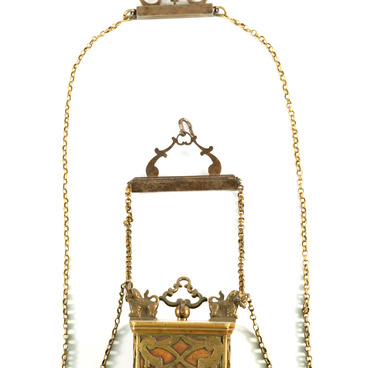This is a traditional attire of women who lived in the southern part of the Urals. It was made in the late 19th century. The main item of the women’s costume is a long dress cut at the waist, with a frill. Usually, it was decorated with applique and embroidery.
#4
Bashkir women’s costume
#3
#11
Apron
#5
Over the dress there is a silk crimson apron embroidered with large green leaves and a gold-coloured floral motif. The apron is fastened in two places — at the short stand-up collar and at the waist. It snugly fits the woman’s bosom narrowing at the waist and widening towards the bottom.
The lining of the apron is made of calico with a red and white paisley print. Instead of an apron, Bashkir girls could use a close-fitting vest, kamzul. Woollen and velvet kamzuls were decorated with a gold braiding.
#12
Headgear
#6
The headgear is a Bashkir skullcap, tyubeteyka, embroidered with beads. It is made of several kinds of fabric: black velvet, crimson plush and black cotton. Draped over the tyubeteyka is a home-woven kerchief in checks. It was tied Tatar style — two adjoining ends under the chin. The image of the trans-Uralian women’s costume is complemented with a bib worn on ceremonial occasions.
#13
Bib
#7
The bib of this costume is called yaga. It is rectangular and is decorated with little clinking silver coins. Their number could be different: the wealthier the family the more coins there were on the yaga. There are forty two on this one. It is made of blue calico. It has a black woollen strip around the neck. Sometimes, along with old coins, cowries or corals could be sewn on the bib.
#14
Footwear
#8
Bashkir women’s footwear was colour shoes or soft leather booties with the top made of canvas, chitek. In summer they wore bast shoes. Booties and shoes were decorated with bright embroidery, colour appliques, frills and woven patterns. The ceremonial costume of an adult woman was complemented with a lot of jewellery.
Leather booties decorated with a floral applique.
#9
Bashkir clothes of the 19th century combined a traditional costume of steppe nomads and that of sedentary tribes. In the steppe part of Bashkiria, preference was given to the Central Asian wardrobe: loose outer clothes, wide pants and a fur cap with large ear flaps, malakhai. The clothes of forested region inhabitants were closer to Tatar clothes: a robe, a caftan with a stand-up collar, beshmet; a chekmen — something in-between an oriental robe and a caftan, men’s felt caps and women’s caps decorated with coins.
#15
Kulmek
#10
The base of the Bashkir women’s costume was a dress or a robe, kulmek. Kulmek had a closed collar, long sleeves and a wide ankle-high bottom. One canvas robe took about seven meters of cloth. The sleeves and the front were decorated with diapering and arc-wise sewn-on stripes. An inseparable part of the women’s costume was loose wide-leg pants, yshtan. Their cut was the same as men’s pants but the fabric was finer and softer. Popular in the upper strata of Bashkir society were colourful gowns made of Central Asian silk.
#16
O.E. Kler Sverdlovsk State Regional Ethnography Museum (SOKM)
read morehide
00:00
00:00
1x
Bashkir women’s costume
Creation period
Late 19th century
Exhibition
3
Open in app
Share

